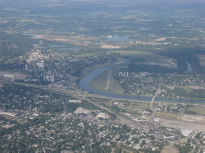FOR IMMEDIATE RELEASE
ACS News Service Weekly PressPac: November 18, 2009
Hidden threat Elevated pollution levels near regional airports
“Aircraft Emission Impacts in a Neighborhood Adjacent to a General Aviation Airport in Southern California”
- Environmental Science & Technology
Scientists are reporting evidence that air pollution — a well-recognized problem at major airports — may pose an important but largely overlooked health concern for people living near smaller regional airports. Those airports are becoming an increasingly important component of global air transport systems. The study, one of only a handful to examine airborne pollutants near regional airports, suggests that officials should pay closer attention to these overlooked emissions, which could cause health problems for local residents. It appears online in ACS’ Environmental Science & Technology, a semi-monthly journal: “Aircraft Emission Impacts in a Neighborhood Adjacent to a General Aviation Airport in Southern California”.
In the new study, Suzanne Paulson and colleagues note that scientists have known for years that aircraft emissions from fuel burned during takeoffs and landings can have a serious impact on air quality near major airports. Aircraft exhaust includes pollutants linked to a variety of health problems. However, researchers know little about the impact of such emissions at general aviation or regional airports, which tend to be located closer to residential neighborhoods than major airports, the article notes.
The scientists measured a range of air pollutants near a general aviation airport for private planes and corporate jets in Southern California (Santa Monica Airport) in the spring and summer of 2008. They found that emissions of so-called ultrafine particles, which are less than 1/500th width of a human hair, were significantly elevated when compared to background pollution levels. Levels of these pollutants were up to 10 times higher at a downwind distance from the airport equal to about one football field and as much as 2.5 times higher at distance equal to about six football fields. The study suggests that “current land-use practices of reduced buffer areas around local airports may be insufficient.”
![]()
Contact
Science Inquiries: Michael Woods, Editor, 202-872-6293
General Inquiries: Michael Bernstein, 202-872-6042
a bigger air pollution threat than
previously thought.
Credit: Wikimedia Commons
(High-resolution version)


